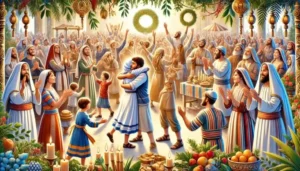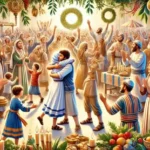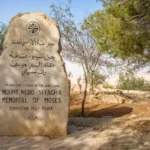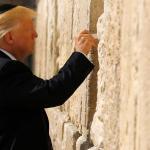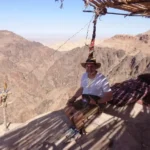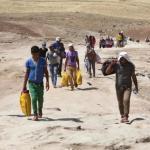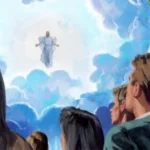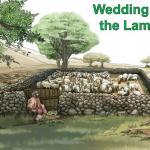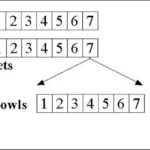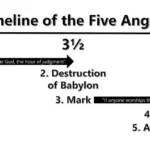Last Updated on December 6, 2024 by Steve
Introduction
In this two part series on the “Timeline of the Five Angels” I am examining the declarations of five angels which covers the entire final seven years. It is a recapitulation of the 70th week in another way and the five angels cover the major events of the period described in Rev. 14:6–20. The story of the final seven years is getting told in different ways. John’s vision gives us loads of views of the same things happening throughout. The Revelation vision is not sequential from beginning to end but there are many sequences within that whole timeline and one of those sequences happens to be the warnings and declarations of the five angels. Remember, the Hebrews teach in blocks, which means ideas and themes and pictures. We have to take off our Greek thinking hats and put on our Hebrew hats if we are going to understand the Book of Revelation. That is why it so hard for us because it is not what we are used to and we think like Greeks in the west.
In part 1, we examined the declarations of the first three angels. In part 2 here, I look at the last two declarations of the last two angels and we see that they are two harvests that cover the last ten days of the age as we know it just before the millennial kingdom.
The fourth angel
In John’s vision he saw one like a son of man who was seated on a white cloud with a gold crown and a sickle in his hand. Who do you think that is? Christ! He referred to Himself as the Son of Man many times when He was on earth.
Then another angel (the fourth one) calls out to the Son of Man (Jesus) telling Jesus to take His sickle and reap. This is a wheat harvest, a harvest of the righteous, and it refers to the elect immediately after the tribulation.1 Who are the elect? See the article “Who are the elect in the Olivet Discourse?”
Matt. 24:30 refers to the sign of the Son of Man that will appear in the sky. Everyone will see the Son of Man coming on the clouds of the sky. This very reference is the same as this harvest of the righteous. What is the sign of the Son of Man? Jesus seated on the cloud with a sickle perhaps?
Symbolically Jesus swings His sickle over the earth. Notice that this is a harvest of grain because the sickle used is in the Greek, a drepanon, a large curved machete type blade. Jesus referred to this wheat harvest in Matt. 13:24–30, 36–43. This harvest occurs when the rapture occurs, the 1st resurrection, 6000 years after the first day of creation. On our five angel’s timeline, this corresponds to the Feast of Trumpets—Rosh Hashanah—the day that no man knows. The angels go out and gather all God’s people who have survived and they are changed in the twinkling of an eye—instantaneously. Of course Paul tells us that the dead in Christ will rise first.2
The fifth angel
The fifth and final declaration on our angel’s timeline is the “Harvest of the Wicked” in Rev. 14:17–20. The fifth angel also has a sickle and he has a message at the very end of the seven years. It is a harvest of judgment and wrath against those who have followed the beast and received his mark. In contrast to the wheat harvest representing the righteous this is a harvest of grapes representing the wicked on the earth. They are rebellious and need to be squashed like grapes. Of course many have already been ‘weeded’ out but there are millions still remaining who come against Christ at the Battle of Armageddon on the Day of the Lord.
This harvest occurs at the “winepress” and it refers to the Battle of Armageddon because of the reference to the winepress in Joel 3:13. The winepress is the Valley of Decision, the Valley of Jehoshaphat.3 Jehoshaphat means “The LORD judges” and the Valley of Decision means “God decides”.
Where is the Valley of Jehoshaphat? The battle occurs at Armageddon (Valley of Megiddo) in the north. It is the winepress outside of the city of Jerusalem which eventually leads down to the Dead Sea. It is there that the blood is up to the horses’ bridle (5 feet) and it flows for 1600 stadiums (1 stadium=600 feet), that is up to 300 km from the Valley of Megiddo to the Dead Sea.
But how can there be so much blood up to a depth of 5 feet for hundreds of kilometres? Impossible you might say. Well, as an example that perhaps gives us an insight to what is meant, there is a commentary on a historical battle in Bethar Israel in the Judean mountains in 135 CE. It was the last standing stronghold of the Bar Kokhba revolt, and was destroyed by the Imperial Roman Army under Emperor Hadrian. The Midrash Lamentation (Commentary on Lamentations) Rabbah by A. Cohen says, “They (the Romans under Hadrian) slew the inhabitants until the horses waded in blood up to the nostrils, and the blood rolled along stones and flowed into the sea, staining it for a distance of 6 km.” But geography indicates that in fact Bethar where this occurred was 60 km from the sea because it is located in today’s West Bank just west of Jerusalem. But the point is that blood can travel a long way or at least the stain of blood can travel a long way.
They (the Romans under Hadrian) slew the inhabitants until the horses waded in blood up to the nostrils, and the blood rolled along stones and flowed into the sea, staining it for a distance of 6 km.
The blood stains are as high as the horses’ bridle—i.e. the horses’ nostrils like in the Midrash commentary on Lamentations and the stain of blood can be seen up to 300 km away such is the slaughter. So, a great slaughter occurs in the very last days of the tribulation. Never has there ever been such a slaughter. So great is the slaughter that takes place, that God commands the birds of the air to come and feast on the flesh and gorge themselves.4 The prophet Ezekiel mentions the same thing.5
What is the original context for grapes being trampled in a winepress? In Biblical days, grapes were put into a large trough or even a depression in the bedrock right there in the garden and the grapes were trampled by foot to remove the wine or the juice of the grape. We saw an example of one in Nazareth when we travelled to Israel in 2013. The treading of grapes was used in the Old Testament as a figure for the execution of divine wrath on the ungodly.6
Summary
Let’s review what takes place over the seven years tribulation using the five angels timeline. Each angel has a declaration that sees the progression from the beginning of the seven year tribulation period to the end. It provides an alternative picture and evidence of what is going to take place in the final seven years…
- The first angel begins at the start of the seven years with the eternal gospel flying in mid-air and proclaiming it throughout the whole earth. He says to fear God and give him glory because His judgments are coming. These are the first four trumpet judgments that will be unleashed during the first half of the 70th. The first angel is warning people to repent and believe in the gospel that has eternal consequences.
- The second angel comes in the middle of the 70th week, when Babylon is destroyed. The warning is to come out of Babylon and escape.
- The third angel describes the beast system, its mark, and the worship of the image described in chapter 13. This occurs throughout the last half of the 70th week and the angel is warning the earth not to take the mark and worship the beast. The consequences will be eternal damnation.
- The fourth angel happens at the Feast of Trumpets, ten days before the Day of the Lord and he describes the rapture of His people—the wheat harvest.
- The fifth angel happens on the very last day and it is the grape harvest where millions of people will be destroyed in the proverbial winepress. God’s wrath will be demonstrated and mercy will disappear. The time for judgment is now here and the birds of the air will gorge themselves on the flesh.
Basically, for those who don’t heed the warnings of the first three angels, they will be harvested in the winepress and crushed like grapes. For those who do heed the warnings, a wheat harvest, a rapture is the reward.




